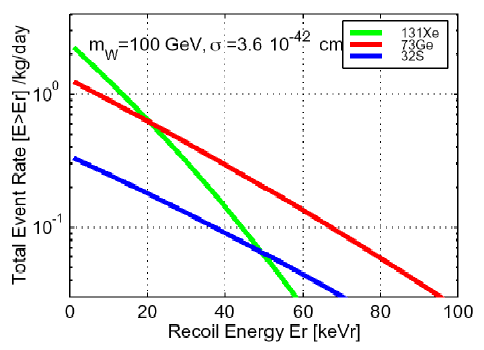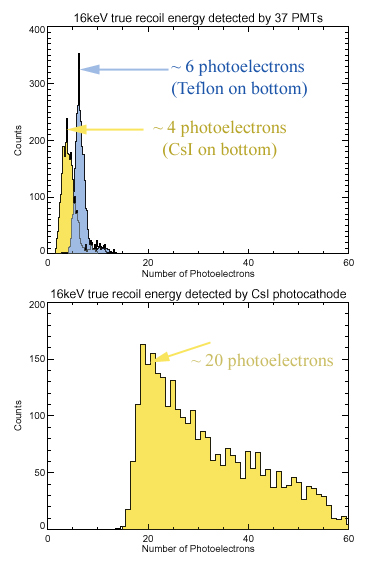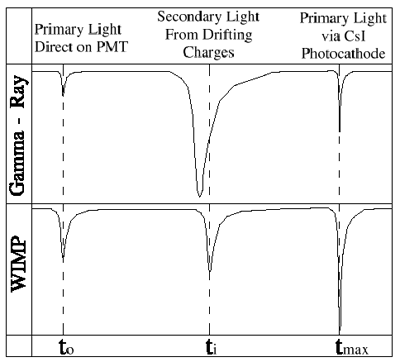|
|
XENON10 Experiment
Expected Signal

Liquid xenon is an attractive target for a sensitive WIMP search. Its high
density ( ~3 g/cm3 ) and high atomic number (Z = 54, A = 131) allow
for a compact detector geometry. The high mass of the Xe nucleus is favorable
for WIMP scalar interactions, provided a low recoil energy threshold, as shown
in the above figure. The expected event rate, integrated above the energy
threshold, is calculated for Xe, Ge and Si, assuming a 100 GeV WIMP with a
cross-section = 3.6E-42 cm2. As detector material LXe has excellent
ionization and scintillation properties. With the simultaneous measurement of
charge and light and 3D position resolution, event information can be maximized
to achieve effective and redundant background identification and discrimination
power, while maintaining most of the target active. Xenon, which contains both
odd and even isotopes for coherent and purely spin-dependent WIMP interactions,
is available in large quantities at reasonable cost. Various techniques have
demonstrated ultra pure LXe in which an electron lifetime in excess of 1 ms
allows the drift of free electrons over 30 cm and longer. The reduction of the
krypton contamination in natural xenon to the required part per billion (ppb)
level has also been verified with a distillation tower and cold
traps.


Most events will provide three signals, with a timing scheme shown
schematically in above Figure. The first is the prompt scintillation signal
detected directly by the PMTs. The last is the proportional scintillation
signal from the CsI photoelectrons drifting the entire 30 cm liquid gap. These
two signals are separated by exactly 150 microseconds, i.e. the maximum drift
time. The proportional scintillation signal from the drift of ionization
electrons can occur anywhere in between these two. The difference in arrival
time between the primary scintillation pulse and the proportional pulse from
the electron drift measures the interaction depth (Z-coordinate) of the event.
Since electron diffusion in LXe is small, the proportional scintillation pulse
is produced in a small spot with the same X-Y coordinates as the interaction
site. The photons in the proportional scintillation will spread over several
PMTs in the vicinity of this spot. By applying a position reconstruction
algorithm, the X-Y position can be reconstructed to about 1 cm precision. The
X-Y information, along with the absolute Z, gives a 3D localization which will
permit further background discrimination via fiducial volume cuts. For events
where the rest pulse is below detection threshold, the third pulse will always
be present since the CsI has high quantum efficiency and the signal is
amplified by proportional scintillation. The Z-coordinate can still be inferred
from the relative drift time difference, since the third pulse contains the
same information as the first. In such events with incomplete signatures, the
sum signal from the wire structure will be present only if a proportional
scintillation pulse is detected. Based on the redundant information in our
design and the 3D position sensitivity, we expect to achieve a background
rejection efficiency better than 99.5% and energy threshold as low as few
keV.
 Top Top
|